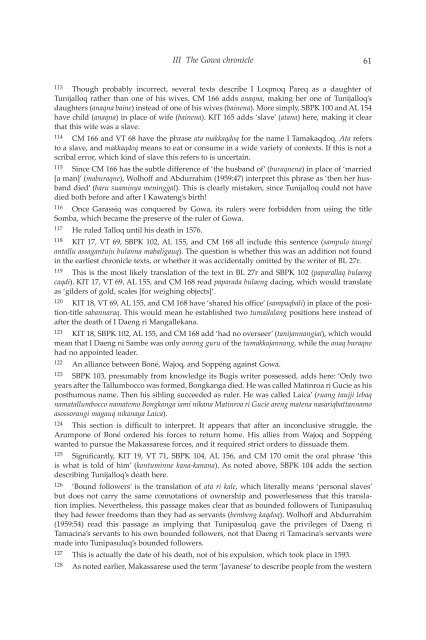A CHAIN OF KINGS - Books and Journals
A CHAIN OF KINGS - Books and Journals
A CHAIN OF KINGS - Books and Journals
You also want an ePaper? Increase the reach of your titles
YUMPU automatically turns print PDFs into web optimized ePapers that Google loves.
III The Gowa chronicle 61<br />
113 Though probably incorrect, several texts describe I Loqmoq Pareq as a daughter of<br />
Tunijalloq rather than one of his wives. CM 166 adds anaqna, making her one of Tunijalloq’s<br />
daughters (anaqna baine) instead of one of his wives (bainena). More simply, SBPK 100 <strong>and</strong> AL 154<br />
have child (anaqna) in place of wife (bainena). KIT 165 adds ‘slave’ (atana) here, making it clear<br />
that this wife was a slave.<br />
114 CM 166 <strong>and</strong> VT 68 have the phrase ata makkaqdoq for the name I Tamakaqdoq. Ata refers<br />
to a slave, <strong>and</strong> makkaqdoq means to eat or consume in a wide variety of contexts. If this is not a<br />
scribal error, which kind of slave this refers to is uncertain.<br />
115 Since CM 166 has the subtle difference of ‘the husb<strong>and</strong> of’ (buraqnena) in place of ‘married<br />
[a man]’ (maburaqne), Wolhoff <strong>and</strong> Abdurrahim (1959:47) interpret this phrase as ‘then her husb<strong>and</strong><br />
died’ (baru suaminya meninggal). This is clearly mistaken, since Tunijalloq could not have<br />
died both before <strong>and</strong> after I Kawateng’s birth!<br />
116 Once Garassiq was conquered by Gowa, its rulers were forbidden from using the title<br />
Somba, which became the preserve of the ruler of Gowa.<br />
117 He ruled Talloq until his death in 1576.<br />
118 KIT 17, VT 69, SBPK 102, AL 155, <strong>and</strong> CM 168 all include this sentence (sampulo taungi<br />
antallu assagantuju bulanna mabaligauq). The question is whether this was an addition not found<br />
in the earliest chronicle texts, or whether it was accidentally omitted by the writer of BL 27r.<br />
119 This is the most likely translation of the text in BL 27r <strong>and</strong> SBPK 102 (paparallaq bulaeng<br />
caqdi). KIT 17, VT 69, AL 155, <strong>and</strong> CM 168 read paparada bulaeng dacing, which would translate<br />
as ‘gilders of gold, scales [for weighing objects]’.<br />
120 KIT 18, VT 69, AL 155, <strong>and</strong> CM 168 have ‘shared his office’ (sampaqbali) in place of the position-title<br />
sabannaraq. This would mean he established two tumailalang positions here instead of<br />
after the death of I Daeng ri Mangallekana.<br />
121 KIT 18, SBPK 102, AL 155, <strong>and</strong> CM 168 add ‘had no overseer’ (tanijannangiai), which would<br />
mean that I Daeng ni Sambe was only anrong guru of the tumakkajannang, while the anaq buraqne<br />
had no appointed leader.<br />
122 An alliance between Boné, Wajoq, <strong>and</strong> Soppéng against Gowa.<br />
123 SBPK 103, presumably from knowledge its Bugis writer possessed, adds here: ‘Only two<br />
years after the Tallumbocco was formed, Bongkanga died. He was called Matinroa ri Gucie as his<br />
posthumous name. Then his sibling succeeded as ruler. He was called Laica’ (ruang taujji lebaq<br />
namatallumbocco namatemo Bongkanga iami nikana Matinroa ri Gucie areng matena nasariqbattannamo<br />
asossorangi magauq nikanaya Laica).<br />
124 This section is difficult to interpret. It appears that after an inconclusive struggle, the<br />
Arumpone of Boné ordered his forces to return home. His allies from Wajoq <strong>and</strong> Soppéng<br />
wanted to pursue the Makassarese forces, <strong>and</strong> it required strict orders to dissuade them.<br />
125 Significantly, KIT 19, VT 71, SBPK 104, AL 156, <strong>and</strong> CM 170 omit the oral phrase ‘this<br />
is what is told of him’ (kontuminne kana-kanana). As noted above, SBPK 104 adds the section<br />
describing Tunijalloq’s death here.<br />
126 ‘Bound followers’ is the translation of ata ri kale, which literally means ‘personal slaves’<br />
but does not carry the same connotations of ownership <strong>and</strong> powerlessness that this translation<br />
implies. Nevertheless, this passage makes clear that as bounded followers of Tunipasuluq<br />
they had fewer freedoms than they had as servants (bembeng kaqdoq). Wolhoff <strong>and</strong> Abdurrahim<br />
(1959:54) read this passage as implying that Tunipasuluq gave the privileges of Daeng ri<br />
Tamacina’s servants to his own bounded followers, not that Daeng ri Tamacina’s servants were<br />
made into Tunipasuluq’s bounded followers.<br />
127 This is actually the date of his death, not of his expulsion, which took place in 1593.<br />
128 As noted earlier, Makassarese used the term ‘Javanese’ to describe people from the western









![Am HaSefer [Volk des Buches] - Books and Journals](https://img.yumpu.com/20648352/1/174x260/am-hasefer-volk-des-buches-books-and-journals.jpg?quality=85)







